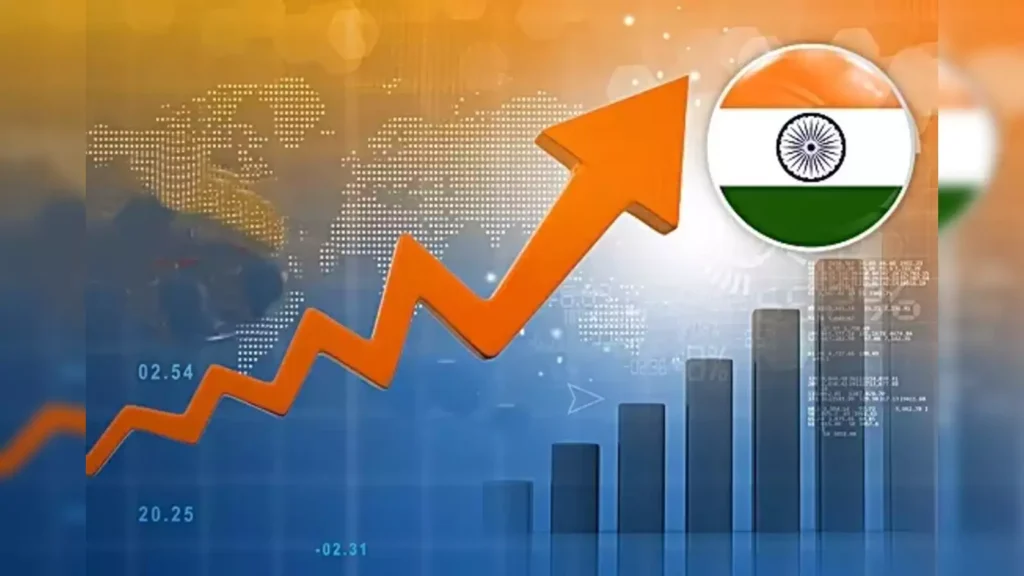India’s economy is projected to grow between 6.3% and 6.8% in the 2025-26 financial year, according to early government estimates ahead of the annual budget announcement. This forecast suggests a slowdown compared to previous years, as economic activity faces multiple headwinds, including subdued domestic demand, slower corporate investments, and a weaker manufacturing sector.
The economy is already expected to slip to 6.4% growth in the current financial year (2024-25)—the slowest pace in four years—compared to a robust 8.2% expansion in 2023-24. This slowdown aligns with expectations of global economic uncertainty, fluctuating commodity prices, and tightening monetary policies worldwide.
India’s Growth Slowdown: Key Factors at Play
1. Declining Private Consumption Amid Inflationary Pressures
One of the biggest contributors to India’s slowing growth trajectory is weak private consumption, which accounts for nearly 60% of India’s GDP.
- Persistently high food and fuel prices have dented household purchasing power, forcing many families to cut back on discretionary spending.
- Stagnant wage growth has also played a role, with lower real incomes reducing the ability of middle-class and lower-income households to spend on goods and services.
- Rural demand remains tepid, as erratic monsoon rains in some regions have impacted agricultural output, leading to slower income growth in the farming sector.
The government is expected to introduce targeted fiscal measures in the upcoming budget to stimulate consumption, including tax reliefs, rural spending programs, and social welfare incentives.
2. Weakness in the Manufacturing and Industrial Sector
India’s manufacturing industry, a key pillar of the economy, has struggled with slowing exports, high input costs, and weaker domestic demand.
- The Production Linked Incentive (PLI) scheme, launched to boost local manufacturing, has not yet yielded the expected benefits across all sectors.
- Some industries, including automobiles, electronics, and pharmaceuticals, have maintained steady growth, but textiles, steel, and heavy engineering sectors have seen weaker demand.
- Supply chain disruptions and geopolitical tensions, including the ongoing Red Sea shipping crisis, have raised costs for import-dependent industries.
To counter these challenges, the government may reduce import tariffs on essential manufacturing components to encourage domestic production and make Indian goods more competitive in international markets.
3. Corporate Investment Slowing Despite Policy Reforms
A key concern for policymakers is sluggish private sector investment, which has failed to accelerate despite various government incentives.
- High borrowing costs—due to the Reserve Bank of India’s (RBI) tight monetary policy—have discouraged many companies from making large capital expenditures.
- Large conglomerates, including Reliance, Tata, and Adani, have continued investing, but mid-sized and small businesses are struggling with limited access to credit.
- The real estate sector, which has seen a strong revival in urban areas, remains unevenly distributed, with luxury housing thriving but affordable housing projects stagnating.
Finance Minister Nirmala Sitharaman’s budget on February 1 is expected to introduce corporate tax incentives and easier access to credit to revive investment sentiment.
How the Government Plans to Respond
Given the economic slowdown, the Modi government is likely to focus on boosting domestic demand, easing supply-side constraints, and maintaining fiscal discipline in its upcoming budget. Key policy measures under consideration include:
1. Increased Infrastructure Spending
The government is expected to increase capital expenditure (capex) allocation, particularly in:
- Transport (roads, railways, and airports) to create jobs and improve logistics.
- Renewable energy projects, including solar and wind power, to meet India’s sustainability goals.
- Urban infrastructure, such as affordable housing and smart city projects, to drive real estate growth.
2. Fiscal Support for MSMEs and Rural India
Micro, Small, and Medium Enterprises (MSMEs) contribute 30% of India’s GDP and employ millions. However, many businesses are struggling with high borrowing costs and slower demand. Potential budget measures include:
- Lower interest rates on government-backed MSME loans.
- Easier compliance norms for small businesses, reducing regulatory burdens.
- Expanded rural employment guarantee programs to increase disposable incomes in rural areas.
3. Possible Tax Relief for the Middle Class
With high inflation eating into savings, the government may announce income tax relief measures, such as:
- Higher tax exemption limits for salaried individuals.
- Incentives for homebuyers, such as increased deductions on home loan interest.
- Cuts in indirect taxes (GST) on essential goods, particularly food and fuel.
4. Strengthening the Manufacturing Sector
To revive manufacturing growth, the government may:
- Expand the Production Linked Incentive (PLI) scheme to more industries.
- Reduce import duties on critical raw materials.
- Enhance R&D incentives to encourage domestic innovation.
Global Factors Influencing India’s Growth
While domestic challenges play a significant role, global macroeconomic conditions will also impact India’s growth in 2025-26.
1. Global Inflation and Interest Rate Trends
- The US Federal Reserve and European Central Bank’s monetary policies will influence global liquidity flows.
- If US interest rates remain high, foreign investors may pull funds from emerging markets like India, affecting stock markets and currency stability.
2. China’s Economic Slowdown
- China’s sluggish recovery post-pandemic could impact India’s exports, especially in metals, chemicals, and IT services.
- However, some Indian companies could benefit from supply chain shifts as global firms diversify away from China (the “China Plus One” strategy).
3. Geopolitical Risks and Trade Disruptions
- The ongoing Red Sea shipping crisis has led to rising freight costs for Indian exporters.
- Escalating tensions in the Middle East and Ukraine-Russia conflict continue to fuel commodity price volatility, affecting India’s oil import bill.
Stock Market and Investor Sentiment
India’s stock markets, which have seen record highs in recent months, experienced a correction due to concerns over slowing GDP growth.
- Foreign investors have become cautious amid global volatility.
- Domestic institutional investors, however, remain bullish on long-term prospects.
- Key sectors expected to perform well in 2025 include technology, pharmaceuticals, banking, and renewable energy.
Despite near-term concerns, analysts remain optimistic about India’s long-term potential, citing:
- A strong demographic dividend (young workforce).
- Rising digital economy growth, driven by fintech, e-commerce, and AI.
- Government focus on self-reliance and infrastructure investments.
Conclusion: Navigating Growth Challenges in 2025-26
India’s economy is projected to grow between 6.3% and 6.8% in 2025-26, reflecting a moderate slowdown from previous years. The government faces critical policy choices to maintain economic momentum while addressing inflationary pressures, weak private consumption, and slowing corporate investments.
The upcoming budget on February 1, 2025, will be crucial in shaping India’s economic path. Key focus areas will likely include infrastructure spending, tax relief measures, manufacturing incentives, and support for MSMEs.
While global uncertainties and domestic challenges pose risks, India’s strong fundamentals, digital transformation, and policy interventions are expected to keep the economy on a steady growth path.
Ready to take your career to the next level? Join our dynamic courses: ACCA, HESI A2, ATI TEAS 7 , HESI EXIT , NCLEX – RN and NCLEX – PN, Financial Literacy!🌟 Dive into a world of opportunities and empower yourself for success. Explore more at Serrari Ed and start your exciting journey today! ✨
photo source: Google
By: Montel Kamau
Serrari Financial Analyst
31st January, 2025
Article, Financial and News Disclaimer
The Value of a Financial Advisor
While this article offers valuable insights, it is essential to recognize that personal finance can be highly complex and unique to each individual. A financial advisor provides professional expertise and personalized guidance to help you make well-informed decisions tailored to your specific circumstances and goals.
Beyond offering knowledge, a financial advisor serves as a trusted partner to help you stay disciplined, avoid common pitfalls, and remain focused on your long-term objectives. Their perspective and experience can complement your own efforts, enhancing your financial well-being and ensuring a more confident approach to managing your finances.
Disclaimer: This article is for informational purposes only and does not constitute financial advice. Readers are encouraged to consult a licensed financial advisor to obtain guidance specific to their financial situation.
Article and News Disclaimer
The information provided on www.serrarigroup.com is for general informational purposes only. While we strive to keep the information up to date and accurate, we make no representations or warranties of any kind, express or implied, about the completeness, accuracy, reliability, suitability, or availability with respect to the website or the information, products, services, or related graphics contained on the website for any purpose. Any reliance you place on such information is therefore strictly at your own risk.
www.serrarigroup.com is not responsible for any errors or omissions, or for the results obtained from the use of this information. All information on the website is provided on an as-is basis, with no guarantee of completeness, accuracy, timeliness, or of the results obtained from the use of this information, and without warranty of any kind, express or implied, including but not limited to warranties of performance, merchantability, and fitness for a particular purpose.
In no event will www.serrarigroup.com be liable to you or anyone else for any decision made or action taken in reliance on the information provided on the website or for any consequential, special, or similar damages, even if advised of the possibility of such damages.
The articles, news, and information presented on www.serrarigroup.com reflect the opinions of the respective authors and contributors and do not necessarily represent the views of the website or its management. Any views or opinions expressed are solely those of the individual authors and do not represent the website's views or opinions as a whole.
The content on www.serrarigroup.com may include links to external websites, which are provided for convenience and informational purposes only. We have no control over the nature, content, and availability of those sites. The inclusion of any links does not necessarily imply a recommendation or endorsement of the views expressed within them.
Every effort is made to keep the website up and running smoothly. However, www.serrarigroup.com takes no responsibility for, and will not be liable for, the website being temporarily unavailable due to technical issues beyond our control.
Please note that laws, regulations, and information can change rapidly, and we advise you to conduct further research and seek professional advice when necessary.
By using www.serrarigroup.com, you agree to this disclaimer and its terms. If you do not agree with this disclaimer, please do not use the website.
www.serrarigroup.com, reserves the right to update, modify, or remove any part of this disclaimer without prior notice. It is your responsibility to review this disclaimer periodically for changes.
Serrari Group 2025












